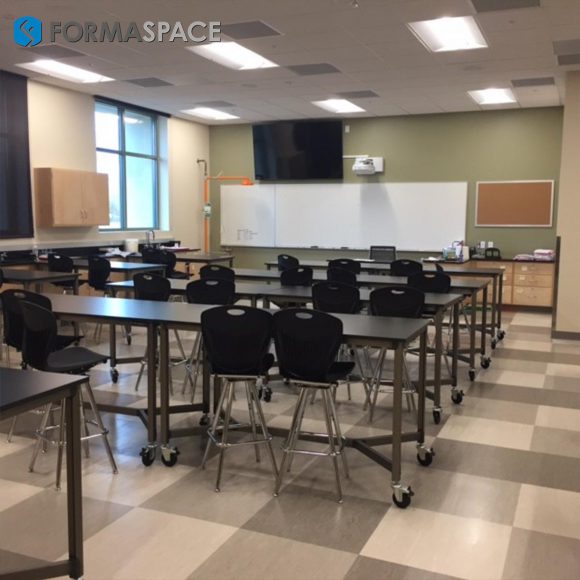Can We Build Better Security Measures into Office Buildings and Schools that Help Prevent Active Shooter Tragedies?
In this Formaspace report, we look at ten ways schools and offices can be better prepared to handle dangerous active shooter events.
1. Enroll Office Managers and School Administrators in Active Shooter Response Training
The Cyberspace Infrastructure Security Agency (CISA) is the division within the Department of Homeland Security (DHS) that offers important resources, including training, to help protect schools and workplaces from the threat of active shooter events.
This CISA video outlines six important aspects of a potential violent shooting event: upfront recognition, prevention, protection, mitigation, response, and recovery.
CISA’s School Safety Task Force (SSTF) provides a clearinghouse for these resources at SchoolSafety.Gov. Here, you can find tools to evaluate your security threats, identify mitigation steps you can take, find grant funding resources to help pay for security upgrades, learn about active shooter preparedness, violence de-escalation techniques, school security and resilience, and insider threat mitigation.
School administrators and office managers responsible for security will find themselves better prepared to handle an active shooter scenario after participating in these available CISA training programs and webinars.
2. Expect the Unexpected: Preparation / Planning / Practice
Preparation is key. As part of this preparation, your school or work organization will need to create an active shooter response plan, which should be practiced through regular safety drills.
Many of us are familiar with Run. Hide. Fight. ® — a trademarked approach to safety in the school or the office.
However, according to the CISA webinar on Active Shooter Preparedness, your plans and corresponding practice safety drills also need to address additional key points, such as where to assemble after escaping so that you can be accounted for by law enforcement.
3. Recognize and Act on Potential Threats – Before It’s Too Late
If you see something, say something.
Too often, we discover that friends, relatives, or work colleagues had significant concerns about an individual in the weeks or months leading up to them committing a violent act that results in multiple fatalities.
These warning signs range from uncontrolled rage and violent threats against an individual or an organization to the expression of suicidal thoughts – possibly combined with a recent acquisition of a gun, knife, or other dangerous weapon.
In the case of the recent Louisville, Kentucky, office shootings, the coworkers knew their coworker who eventually killed five employees at the bank was struggling. The family of the gunman Robert Card, who recently killed over a dozen people in Lewiston, Maine, were concerned about his mental health months before he went on the shooting rampage.
Take these concerns seriously and act appropriately – and proactively.
The life you save may be your own.
Many states have red flag laws that provide a legal mechanism to separate individuals exhibiting mental health problems from their weapons. (Maine had a so-called “yellow” flag law on the books, which requires additional steps before an intervention.)
4. Create a Secure Perimeter that Funnels Traffic Through Security Check Points
After the Alfred P. Murrah Federal Building in Oklahoma City was bombed by Timothy McVeigh in 1995, architectural security specialists began redesigning the outer perimeter of at-risk buildings to make them safer, incorporating features such as bollards to prevent vehicles from ramming in the office lobby, etc.
Since that time, many school campuses have also added comprehensive perimeter security measures to reduce the chance that violent intruders can enter school buildings.
Many schools now require everyone to enter buildings through a single centralized security checkpoint.
Visitors without security passes can be buzzed into the security lobby vestibule, which has a secure window that allows guards to vet visitors and check their driver’s license or other forms of ID against online databases, the so-called “no entry lists.”
(These checkpoints could also be upgraded to include magnetometers to screen for weapons before entering the building.)
Once inside the building, visitors are escorted throughout the time they are in the building.
The situation with office buildings can vary a lot.
Large companies with expansive campuses can emulate the same secure perimeter model used by schools.
However, many office buildings with multiple tenants do not screen visitors as they enter the lobby or ascend the elevators; instead, they rely on less secure reception areas to greet and vet visitors.
5. Consider the Pros and Cons of Adding Additional Armed Security
Should we be relying on adding additional firearms for protection at the school or the office?
There’s been a lot of heated discussion and controversy about whether arming individuals (such as teachers or administrators) will make schools safer or not.
The “pro-gun” states have been requiring schools to hire more armed guards and encourage teachers to bear arms in the classroom to protect the students in case of an active shooter on campus.
However, this may not be a popular idea among teachers nationally. According to a recent study, over half of US teachers think being armed would make schools less safe.
If the policy at the office or the school is to rely on additional firearms for added security, these weapons must remain secure throughout the day yet be accessible in an emergency. In response, some schools are adding fingerprint-activated gun safes that allow pre-authorized, trained gun users to access the firearms in case of emergency while preventing others from doing so.
6. Create and Staff a Comprehensive Camera Surveillance Monitoring Network
Many school and office campuses are making major investments in camera surveillance systems that allow security specialists to monitor the entire facility – to identify any unknown visitors or suspicious activity.
In the event of an active shooter emergency, these cameras can help the security monitoring team find and track the movements of an active shooter assailant and relay the real-time information to law-enforcement officers and first responders – as well as coordinate with teachers in individual classrooms or managers in office areas.
7. Upgrade to a Sophisticated 2-Way Communication System
Another important investment that many school and office campuses are making is improvements in the quality of their communication systems.
Rather than relying on cell phones or a central, one-way public address (PA) system, these new, upgraded communication tools also allow security monitor staff to communicate directly with individual classrooms or office areas to provide potentially life-saving emergency information about a potential active shooter location, location of police or first responders, escape routes, etc.
Some advanced systems can also broadcast an alert to a pre-determined list of cell phones – although care must be taken during an active shooter event to avoid cell phones beeping, which could give away the hiding location of students, teachers, or workers.
8. Improve Door Security with Centralized Locking Systems
One of the important lessons learned from the Columbine High School shootings in Colorado in 1999 is that while the classroom doors could be locked, they could only be locked from the outside and not from the inside. This allowed the active shooter unfettered access to classrooms unless they were blocked on the inside by heavy objects, such as file cabinets or desks wedged against the door.
The newly accepted best practice is a central door-locking system that can be controlled by the security staff in the central monitoring suite – allowing all doors to be locked at once during an emergency.
In many cases, doors are locked by default these days and can only be opened via approved key card access.
It’s also become best practice to provide door window coverings that can be put over windows during an emergency to block the view into office areas or classrooms.
9. Increase Window Security with Bulletproof Glass, Window Egress Features, and Location Signage
Speaking of windows, there have also been major changes to window designs in response to past mass shooting events.
As we mentioned in the door section above, many school and office facilities are making emergency blackout curtains available to prevent assailants from looking inside a classroom or office space.
In some cases, window glazing has also been upgraded to bulletproof glass for increased security.
Many schools and offices are also adding emergency exit features to traditional fixed windows, allowing students or office workers to escape to the outside via an opening window.
Another security change is adding clear location signage that identifies room numbers that can be seen from outside the building. This allows law enforcement and first responders to identify individual classrooms or offices, potentially facilitating an escape or confirming that spaces have been safely evacuated.
10. Incorporate Safe Space Features and Bulletproof Gear into the Safety Plan
The potential for school shootings, while thankfully remote, is understandably on the minds of many parents of school-age children.
As a result, an increasingly popular back-to-school purchase is a “bulletproof” student backpack – or a “bulletproof “ insert that can be added inside a standard backpack.
In some potentially higher-risk workplace settings, such as hospital emergency rooms, some workers have adopted the practice of wearing bulletproof Kevlar vests under their scrubs.
Another recent innovation is the development of high-security whiteboard installations for classrooms or office spaces that can be quickly reconfigured into a bullet-resistant safe space. Developed by Kevin Thomas of KT Security Solutions, these folding wall systems are currently being tested at two schools in Cullman, Alabama.

Formaspace is Your Security Partner
If you can imagine it, we can build it, at our Austin, Texas factory headquarters.
Talk to your Formaspace Sales Representative or Strategic Dealer Partner today to learn more about how we can work together to make your next construction project or remodel a success.








